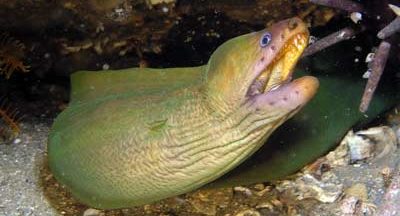This title takes the cake ! ! !
“When an Eel Climbs a Ramp to Eat Squid From a Clamp, That’s a Moray”
Moray eels can hunt on land, and footage from a recent study highlights how they accomplish this feat with a sneaky second set of jaws.
Written content from Sabrina Imbler
In the video, forceps nudge a piece of squid that sits on a ramp as an offering. Suddenly, a snowflake moray eel named Qani heaves its muscled bucatini of a body out of the water and onto the ramp. It opens its mouth and bites the squid. The eel pauses a moment, opens its mouth again and, as if its tongue were a conveyor belt, sucks the squid even deeper into its mouth using a secret second set of jaws in its throat.
This particular eel mukbang, to Rita S. Mehta, an evolutionary biologist at the University of California, Santa Cruz, was cinematic gold: footage that showed the bite, the prey transport with secondary jaws and the swallow. Her team had taped loads of footage of the eels feeding on the ramp, but none that showed the act from beginning to end.
Dr. Mehta first described the moray eel’s second set of choppers, known as pharyngeal jaws, in 2007. When a moray hunts, it seizes its prey with the teeth of its outer jaw, and then its pharyngeal jaws leap forward out of the throat and into the mouth to grasp the prey and drag it deeper into the eel’s body.
Now, Dr. Mehta has described how snowflake eels and other morays use their pharyngeal jaws to feed just as effectively on land as in water, according to a study published this month in The Journal of Experimental Biology.
Like many other fish, morays will eventually dry out if they leave water for too long. But Dr. Mehta and her colleagues cite a study from 1979 that suggests a moray’s outermost layer of skin contains certain mucus glands that may make these eels more resilient to time spent on land.
And morays climbing out of water came as no surprise to some observers. Lana Sinapayen, an artificial life researcher who grew up in the Caribbean island of Martinique, said local fishermen often caught morays by placing squids on the shore and waiting for the eels to arrive. “You only need a solid stick to take your pick,” she wrote in an email. Dr. Sinapayen was not involved in the research but wanted to emphasize that many local people have long known that morays can hunt on land.
When an Eel Climbs a Ramp to Eat Squid From a Clamp, That’s a Moray
Such behavior has also long been reflected in scientific studies. One paper from 1971 describes a moray that clambered into the same tide pool to hunt for five days straight.
When Dani Rabaiotti, an environmental scientist based in London, volunteered at an aquarium as a teenager, she met a moray eel who knew how to slither onto a ledge and wait to be hand-fed. “He’d learned it was easier than hanging out in the water with all the other hungry animals,” she said. Read more from NY Times





